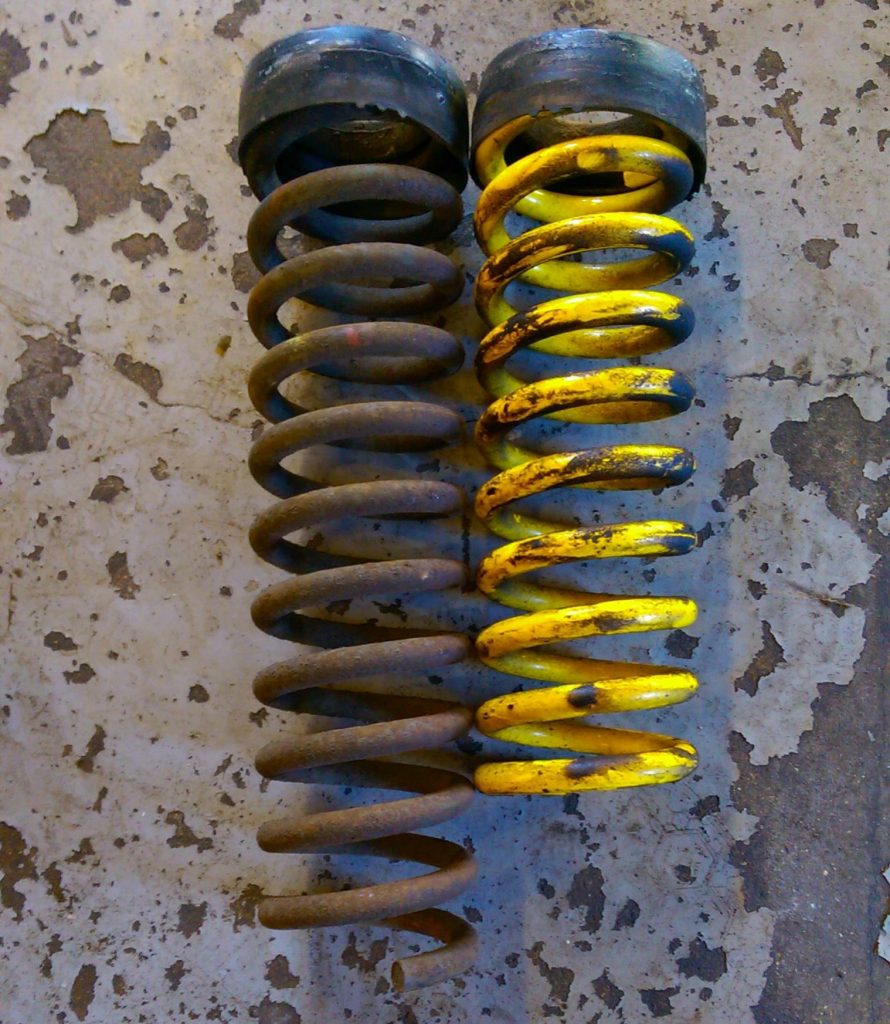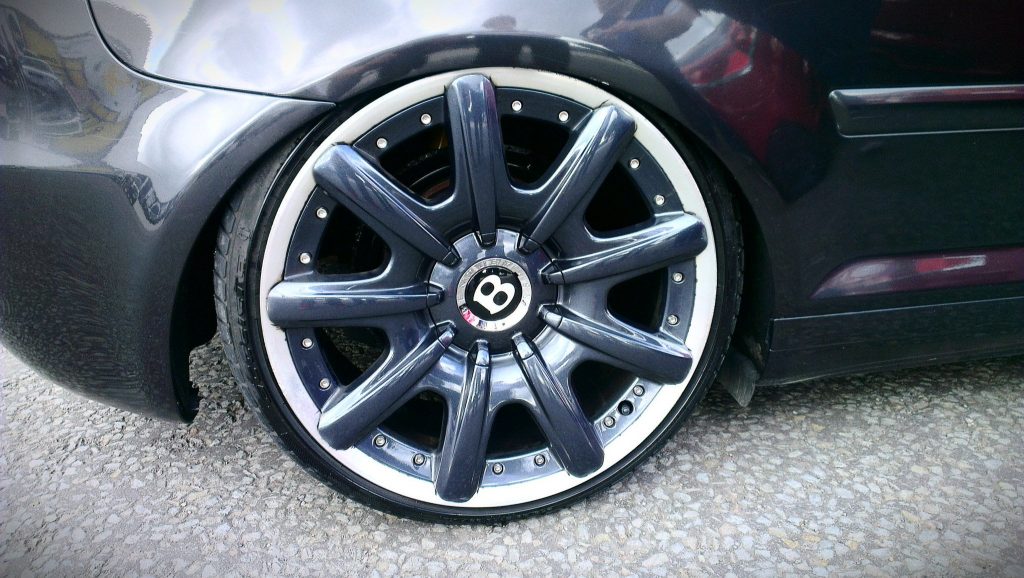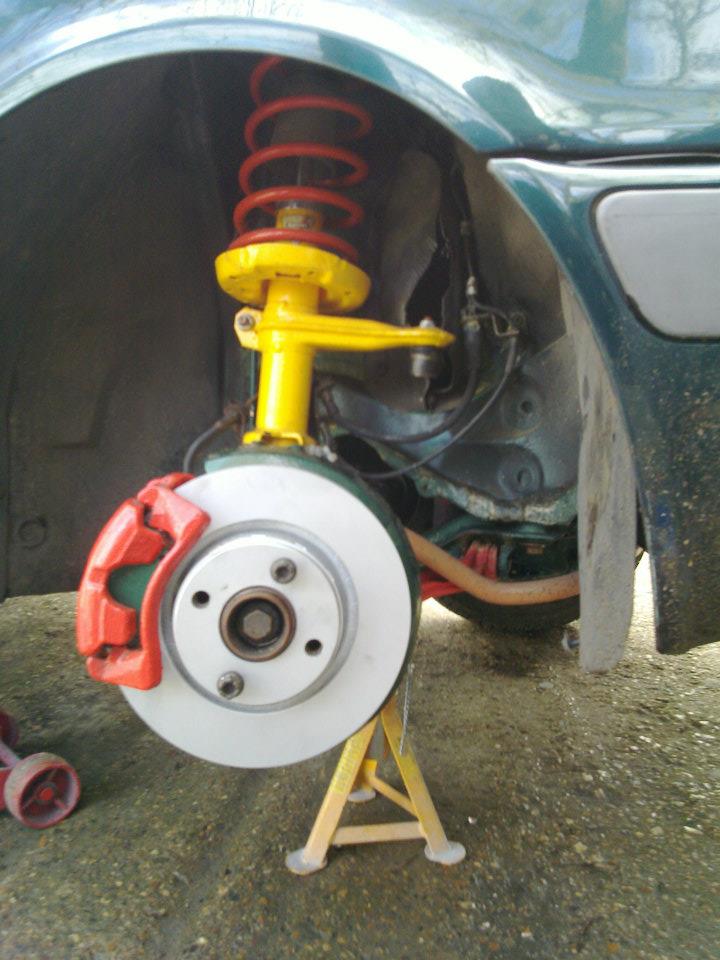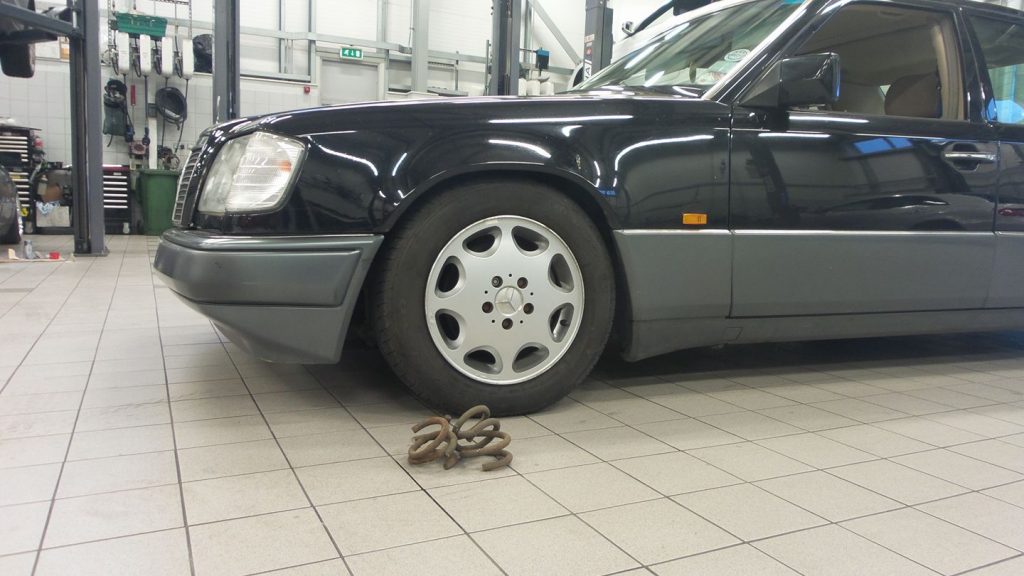Lowering your car is a common modification with a range of benefits and of course drawbacks. Car owners lower their vehicles for cosmetic or performance gain and there are several methods to lowering your car.
The 5 best methods of lowering your car involve:
- Lowering Springs
- Coilovers
- Cut Springs
- Air Suspension
- ECU modification
These will be discussed in great detail in this article.
Each have their own advantages and disadvantages but lowering your car with a certain method is personal preference and what you are looking for. The majority of car owners who are looking for cosmetic look will go with coilovers or air suspension where as performance will be expensive coilovers or lowering springs.
Table of Contents
How to Lower a Car With Lowering Springs
Using lowering springs is the most common method of lowering your car due to the relatively small cost and ease of installation. However, you cannot adjust the height of springs like you can with coilovers, therefore its important that your perform some measurements beforehand.
When lowering a classic Mercedes, I chose to go with a drop of 35mm to reduce the large arch gap. However, compared with the OEM spring (image below) that is already installed, the 35mm looks much greater. For this reason, I much prefer manual measurements rather than reading measurements online.

Before you begin the process of lowering your car with springs, you will need the following:
- Spring Compressor Tool
- Lowering springs designated for your car
- Floor jack or garage car lift
The purpose of the spring compressor tool is to safely remove a coil suspension spring that is under extreme tension. It will latch on to all sizes of spring and using a wrench, you are able to reduce the size of the coil so that it wont recoil in the air (very dangerous). This is an essential tool and must be used when removing a coil spring from a car safely and quickly.
Installing Lowering Springs
- Disconnect Sway Bar. Attached via the lower control arm, the sway bar holds the weight of the car whilst weight is moved side to side when turning. Removing it gives makes the process much easier.
- Compress The Old Spring. Once you have removed the wheel, use the spring compressor tool to compress the coil by tightening the nut at each end of the compressor. You will need to rotate the screw in a clockwise motion to reduce the size of the spring. On some cars, the shock absorber may be located through the center of the coil spring. If this is the case, you will need to remove the shock absorber before compressing the spring.
- Disconnect Bottom and Top A Arms and Ball Joint. Simply remove the bolts found at the top and bottom of the A-Arm and then separate the ball joint from the A-Arm so that the spring can be removed easily.
- Remove The Spring. The spring should be able to pull away (may need some force). Before moving onto the new spring, remove the compressor tool slowly until its back to its original state.
- Compress and Install The New Spring. The new spring will need to be compressed to the same size as the old spring that was removed. Place the new spring in the same place as the old spring.
- Raise Lower Control Arm With Jack. You will now need to properly align the control arm with the suspension components. Use a floor jack to push it up. If you are on a car lift, place a blank of wood on the jack to reduce the gap.
- Connect Ball Joints and Loosen Compressor. Before you release the spring compressor, you must connect the ball joints back up. Once this is done, slowly loosen the spring inside the compressor.
- Connect The Sway Bar. Reattach the sway bar to the lower A Arm that was disconnecting during spring removal.
It is important to note that it will take some time for the car to settle on the springs. So if you were expecting the car to go lower, give it a few hours or you can speed things up by jumping up and down on the door sill.
Lowering Your Car Using Coil Springs Pro’s
- Often higher quality for relatively cheap cost
- Improved corner handling
- Preset Spring Rates and Height – No changes required
- Easiest way to lower a car
- compatible with other suspension components
- Most car insurers prefer coil springs to alternatives
Lowering Your Car Using Coil Springs Con’s
- Fixed height can result in too much or too little arch gap
- More stress on other suspension components i.e. struts
- Ride can be much worse than alternative methods
With regards to the first con, I ran into this issue with the drop on the front being too low. I had already rolled my arches but I was still catching the fender with my wheels. The next step that I regretted was fitting a skinnier tire, which looked terrible.
This resulted in reverting back to the wider and higher profile tire and a different spring setup for the front. A time consuming and costly exercise but at the same time a lesson learnt.

How to Lower a Car With Coilovers
Coilovers is my personal favorite method of lowering a car due to the ability to adjust the height. However, they are as not as readily available for all cars, particularly classic cars that I specialize in.
Coilovers have two forms, the first being the budget coilovers that provides an affordable suspension setup with all the components. Then there are performance/premium coilovers that are made to be race track focused or designed for comfort.
Budget coilovers offer excellent value for money and you will be impressed with amount of suspension components that you actually receive. I had used JOM coilovers for over two years with zero problems and sold them after I returned the car back to stock.
The only issue with budget coilovers is the ride, which is usually very “crashy” and you will be able to feel everything on the road you are driving on.
More expensive coilovers offer track focused setups or comfort but can be more than double the price of the budget coilover setup. If you can afford to, certainly go with the more expensive coilover package.
Installing Coilovers
Fitting coilovers to your car follows the same process as using springs (refer above) with additional parts often included in packages. Such parts come in the form of shorter shock absorbers and drop links.
Adjusting Coilovers To Correct Setting
The biggest benefit of running of installing coilovers is the ability to adjust setting such as height, camber and dampening. The latter is usually only available with more expensive coilovers. Coilovers will usually be partial or fully threaded that require different methods of adjusting.
In both cases, you will be provided with a spanner wrench that you will use to adjust the collar. Do not lose this coilover wrench because it is a pain to get a new one for your coilover.
To adjust the height on coilovers, you will want to use the coilover wrench to spin the collar clockwise to lower the car and counter clockwise the raise the height. It is fairly simply to do and you can put the car on full lock for the front but will need to remove the wheels on the back.

Lowering Your Car Using Coilovers Pro’s
- Adjustable ride height, camber, dampening, rebounds and more
- Springs rates are firmer compared to lowering springs
- Switch the springs within the coilover for different performance
- Interchangeable parts
- Can be cheaper than springs but offer much more
Lowering Your Car Using Coilovers Cons’s
- Cheaper coilovers can often result in a “crashy” ride
- If setup incorrectly, the performance will be unpredictable
- Trial and error to get the correct height settings
- The best coilovers are often quite expensive
- More complex to install than lowering springs
How to Lower a Car with Cut Springs
If you are looking to lower a car without spending any money or on lowering a car cheaply, cutting the spring is the answer. If you have access to an angle grinder, you will be able to chop a coil (or more) from your current suspension. Is cutting spring a recommended method of lowering your car? Of course not.

Although frowned upon, I have covered thousands of miles with cut springs without any issues. If done correctly, chopped springs are safe and is a cheap method to lower a car without any new parts.
Many car enthusiasts believe that a chopped spring may pop out of the perch at any moment but this is a risk that you must take. Although its highly unlikely it would happen unless the spring is cut to a stupid size.
Cutting Springs Properly
You will want to remove the spring as you would with the lowering springs (as shown above) using a compressor tool. Next you will want to decide how much of the coil spring you wish to cut. This can be done using complex maths or simply guess.
Once you have decided how many coils to cut, use an angle grinder to cut through the coil. Do not cut too much straight away. Trial and error with small amount at a time and testing it on the car is the best method. Once cut, place the spring back on the car and let it settle.
It is possible in some cases (easier on the rear) to cut the springs while they are on the car. However, this is risky and not worth the hassle, its much easier to simply remove the spring from the car.
5 Reasons Not to Cut Coil Springs
- The spring will not have been designed to be cut. Some springs have thicker coils at the bottom and thinner coils at the top. This will alter the function of the spring dramatically.
- The car may fail an inspection/MOT if the spring is slightly moved or not sitting correctly in the strut.
- Springs rates would have increased, meaning much more pressure on the shock absorbers.
- The car will not ride as nicely as it did or would have on proper lowering springs.
- The spring is more likely to break as its lots it structural integrity.
It is not advisable yet car owners will continue to cut springs (even I have cut springs!). However, for the average car you can buy a set of lowering spring for around $180 that have been machined be the exactly the same length on every corner.
How to Lower a Car With Air Suspension
Using a custom air suspension setup to lower your car is aimed at enthusiasts looking for the stance look. The main benefit of air suspension is the ability to lift the suspension i.e. fill the air bags at a click of a button. You will also be able to set multiple positions for different usages i.e. driving or parking.
For the best stanced look, air suspension is the best method but you will need to be able to afford a good setup. 4 air bags, compressor, switch panel and then the custom air suspension install does not come cheaply.
The best air suspension kits that are available online are the ones produced by Accuair. The kit comes at a premium but the amount of equipment, documentation, warranty and spare parts available is worth the money. The affordable air suspension kits often require modifications and a complex installation but still work very well.

Installing Air Struts, Compressor and Tank
The installation of a air suspension on a vehicle goes further than simply replacing a spring. You will need to also install a compressor, tank, buttons to control the bags and more. If you do not know what you are doing, I strongly advise that you find a professional to install this for you.
Alternatively, after you have removed the original coil spring and struts, you must continue with the following to install air suspension:
- Install the rear air springs (easier than front)
- Install the front air strut
- Install the air compressor and tank – Usually in boot
- Wire the air compressor to power source
- Wire a controller from the compressor to near the drivers seat for use
Clearly the installation guide to fit air suspension is very brief due to all air suspensions being different. For example, some air bag suspensions can be controlled by iPhone apps so they wont need the controller. Always refer to the manufacturers documentation of installing air ride, however they will more than likely follow the 5 steps above.
What To Look Out For With Air Suspension?
Air suspension will require more maintenance than regular suspension but the benefits are much more rewarding. The most common issue with air suspension that must be repaired as soon as possible is a leak or split in the air bag.
Unless the split or leak is too large, the air bag will refill once the compressor kicks in. This is where the problems will begin. To battle the reduction in air within the bag, the compressor has to work harder to refill to the correct measurements.
This results in extra stress upon the compressor that costs much more to repair than the bag itself.
If the air bag is not refilling even though there is no leak or split, this will be because of a broken air compressor. Electrical problems are very rare if installed properly, so these two issues are the main common problems you should check for.
Lowering Your Car Using Air Suspension Pro’s
- Ability to go much lower than static suspension
- Less scraping as you can raise the height with a click of a button
- Adds value to a car compared to a car slammed on lowering springs
- Better stanced look as you can go to the ground whilst parked
- Much more comfortable ride compared to coilovers or coil springs
Lowering Your Car Using Air Suspension Con’s
- Expensive to buy and install
- Complex installation compared to coilovers/springs
- More maintenance and potential costly repairs
- Potential to “Air Out” whilst driving as its not fixed
- Reduce boot space due to compressor and air tank
How to Lower a Car Modifying the ECU
Want to lower your car for free? Want to have free air suspension? To do this, you will want to buy a car that has air suspension from the manufacturer. This is fairly common and coming from a Mercedes background I can name several such as W220 S Class, W211 E Class and so on.
To do this to your standard air suspension, you will want to purchase some lowering links and have access to an auto scanner to connect to a cars computer. You will be able to calibrate the height of the suspension through the computer i.e. Star Machine for Mercedes.
Should You Lower Your Car?
It wouldn’t be a complete guide to lowering cars with the obvious question, should you lower your car? The two common reasons for lowering a car would be for performance gain in terms of cornering and of course looks i.e. stanced or bagged.
5 Advantages Of Lowering Your Car
- Lower center of gravity for increased stability
- More aerodynamic with less drag as less air going underneath the car
- Improved handling through corners with less body movement
- Improved appearance with less arch gap
- Better fuel economy ass less air resistance
5 Disadvantages Of Lowering Your Car
- Poor ride quality (unless air suspension)
- Increased wear and tear on other suspension components
- Unpredictable handling if not setup correctly
- Damage to wheel arches or underbody if too low
- Reduced practicality i.e. jacks unable to go under the car
Overall, you need to weigh up the pros and cons with whether or not you want to lower your car. Personally my daily driver is slightly lowered with my 6 other vehicles much lower but for looks over performance. If I lived in an area with many speed bumps or poor road surfacing, I highly doubt I would be driving a low car daily.

